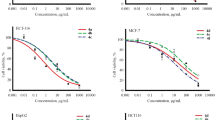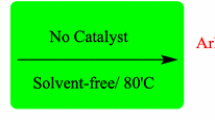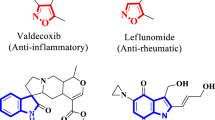Abstract
This work focuses on investigating solvents for the catalyst-free synthesis of 2-amino-4H-chromenes from salicylaldehydes and malononitrile through the Knoevenagel-Michael sequential reaction. The use of ethanol under reflux conditions resulted in the production of several 2-amino-4H-chromenes 5(a-g) with high isolated yields (75-93%) within a short reaction time (60-300 min). Notably, four new compounds, 2-amino-4H-chromenes 5(b,d,e,g), were synthesized for the first time. Virtual screening was performed on the most promising molecules (5b, 5e, and 5 f) against cell lines H-116 and K-562, with 5e demonstrating the most potential in antitumor activity. The in vitro assays validated the high potential exhibited by the 5e molecule, corroborating the in silico findings. Molecular docking analysis suggested a possible mechanism of action for the 5e molecule involving inhibition of the mutant T315l Abl protein. Mutations in the kinase domain of Bcr-Abl commonly lead to resistance to imatinib therapy in chronic myelogenous leukemia patients. This study represents the first investigation into the biological activity of this compound class, offering a promising starting point developing of new antitumor agents.







Similar content being viewed by others
References
Bakthadoss M, Sivakumar G. Highly stereo and chemoselective synthesis of tetra and pentacyclic frameworks using Solid-State Melt Reaction (SSMR). Tetrahedron Lett. 2014;55:1765–70. https://doi.org/10.1016/j.tetlet.2014.01.126
Marcaccini S, Pepino R, Pozo MC, Basurto S, García-Valverde M, Torroba T One-pot synthesis of quinolin-2-(1H)-ones via tandem Ugi–Knoevenagel condensations. TetrahedronLetters, 2004; 35. https://doi.org/10.1002/chin.200435128.
Sharma N, Sharma A, Shard A, Kumar R, Saima, Sinha AK. Pd-catalyzed orthogonal knoevenagel/perkin condensation–decarboxylation–heck/suzuki sequences: tandem transformations of benzaldehydes into hydroxy-functionalized antidiabetic stilbene–cinnamoyl hybrids and asymmetric distyrylbenzenes. Chem A Eur J. 2011;17:10350–6. https://doi.org/10.1002/chem.201101174
Chen C, Yang H, Chen J, Zhang R, Guo L, Gan H, et al. One-pot tandem catalytic synthesis of α, β-unsaturated nitriles from alcohol with nitriles in aqueous phase. Catal Commun. 2014;47:49–53. https://doi.org/10.1016/j.catcom.2014.01.001
Yang F, Wang Z, Wang H, Wang C, Wang L. An efficient condensation of substituted salicylaldehyde and malononitrile catalyzed by lipase under microwave irradiation. RSC Adv. 2015;5:57122–6. https://doi.org/10.1039/c5ra10565j
Smuszkiewicz A, López-Sanz J, Sobczak I, Martín-Aranda RM, Ziolek M, Pérezmayoral E Tantalum vs Niobium MCF nanocatalysts in the green synthesis of chromene derivatives. Catal Today, 2019; 325. https://doi.org/10.1016/j.cattod.2018.06.038.
Kulkarni MA, Pandit KS, Desai UV, Lad UP, Wadgaonkar PP. Diethylamine: A smart organocatalyst in eco-safe and diastereoselective synthesis of medicinally privileged 2-amino-4H-chromenes at ambient temperature. Comptes Rendus Chimie. 2013;16:689–95. https://doi.org/10.1016/j.crc.2013.02.016
González-Rodal D, Palomino GT, Cabello CP. Pérez-Mayoral E. Amino-grafted Cu and Sc Metal-Organic Frameworks involved in the green synthesis of 2-amino-4H-chromenes. Mechanistic understanding. Microporous and Mesoporous Mat. 2021;323:111232 https://doi.org/10.1016/j.micromeso.2021.111232
Curini M, Cravotto G, Epifano F, Giannone G. IL-13: A promising therapeutic target for bronchial asthma. Curr Med Chem. 2006;13:2291–8. https://doi.org/10.2174/092986706777935140
O’kennedy R, Thornes RD Coumarins: Biology, Applications and Mode of Action. Wiley, 1997.
Luo J, Xin T, Wang Y. A Peg bridged tertiary amine functionalized ionic liquid exhibiting thermo regulated reversible biphasic behavior with cyclohexane/isopropanol: synthesis and application in Knoevenagel condensation. New J Chem. 2013;37:269–73. https://doi.org/10.1039/C2NJ40890B
Yadav S, Srivastava M, Rai P, Singh J, Prasad TK, Singh J. Visible light induced, catalyst free, convenient synthesis of chromene nucleus and its derivatives using water–ethanol mixture as a solvent. New J Chem. 2015;39:4556–61. https://doi.org/10.1039/c5nj00002e
Costa M, Areias F, Abrunhosa L, Venâncio A, Proença F. The condensation of salicylaldehydes and malononitrile revisited: synthesis of new dimeric chromene derivatives. J Org Chem. 2008;73:1954–62. https://doi.org/10.1021/jo702552f
Bhat SI, Choudhury AR, Trivedi DR. Condensation of malononitrila with salicylaldehydes and o-aminobenzaldehydes revisited: solvent and catalyst free synthesis of 4H-chromenes and quinolines. RSC Adv. 2012;2:10556 https://doi.org/10.1039/C2RA21849F
Ferreira JMGO, Resende-Filho JBM, Batista PK, Teotonio EES, Vale JA. Rapid and efficient uncatalyzed knoevenagel condensations from binary mixture of ethanol and water. J Brazilian Chem Soc. 2017;29:1382–7. https://doi.org/10.21577/0103-5053.20170240
Ferreira JMGO, Silva GA, Coelho MC, Lima-Junior CG, Vale JA. Quick synthesis of isatin-derived Knoevenagel adducts using only eco-friendly solvent. Res Chem. 2021;3:100135 https://doi.org/10.1016/j.rechem.2021.100135
Ramachary DB, Chowdari NS, Barbas CF. Organocatalytic asymmetric domino knoevenagel/diels–alder reactions: a bioorganic approach to the diastereospecific and enantioselective construction of highly substituted Spiro[5,5]undecane-1,5,9-triones. Angewandte Chemie. 2003;115:4365–9. https://doi.org/10.1002/ange.200351916
Koch A, Tamez P, Pezzuto J, Soejarto D. Evaluation of plants used for antimalarial treatment by the Maasai of Kenya. J Ethnopharmacol. 2005;101:95–99. https://doi.org/10.1016/j.jep.2005.03.011
Kumar R, Pereira RS, Zanetti C, Minciacchi VR, Merten M, Meister M, et al. Specific, targetable interactions with the microenvironment influence imatinib-resistant chronic myeloid leukemia. Leukemia. 2020;34:2087–101. https://doi.org/10.1038/s41375-020-0866-1
Lozzio CB, Lozzio BB. Human chronic myelogenous leukemia cell-line with positive Philadelphia chromosome. Blood. 1975;45:321–34. https://doi.org/10.1182/blood-2016-08-736025. PMID: 163658
McGahon A, Bissonnette R, Schmitt M, Cotter KM, Green DR, Cotter TG. BCR-ABL maintains resistance of chronic myelogenous leukemia cells to apoptotic cell death. Blood. 1994;83:1179–87. https://doi.org/10.1182/blood.V83.5.1179.1179. Erratum in: Blood 1994; 83:3835. PMID: 8118022
Modugno M, Casale E, Soncini C, Rosettani P, Colombo R, Lupi R, et al. Crystal structure of the T315I Abl mutant in complex with the aurora kinases inhibitor PHA-739358. Cancer Res. 2007;67:7987–90. https://doi.org/10.1158/0008-5472.CAN-07-1825
ChemAxon. Marvin. Copyright Ⓒ 1998-2021, ChemAxon Ltd. All Rights Reserved. Copyright Ⓒ 1998–2021 p Copyright Ⓒ 1998-2021, ChemAxon Ltd. All rights reserved.
ChemAxon. Standardizer Software. Chemaxon. Copyright Ⓒ 1998–2021 ChemAxon Ltd. All Rights Reserved. Copyright Ⓒ 1998–2021 p Copyright Ⓒ 1998-2021. ChemAxon Ltd.
Fourches D, Muratov E, Tropsha A. Curation of chemogenomics data. Nat Chem Biol. 2015;11:535 https://doi.org/10.1038/nchembio.1881
Fourches D, Muratov E, Tropsha A. Trust, but Verify II: A practical guide to chemogenomics data curation. J Chem Inf Model. 2016;56:1243–52. https://doi.org/10.1021/acs.jcim.6b00129
TALETE srl. Dragon - Software for Molecular Descriptor Calculation. v. 7.0. Kode Chemoinformatics, 2006. Copyright © 2013 Talete s.r.L. Kode informatics srl: Copyright © 2013 Talete s.r.l. p v. 7.0. Kode chemoinformatics, 2006.
Berthold MR, Cebron N, Dill F, Gabriel TR, Kötter T, Meinl T, et al. KNIME - The Konstanz information miner. ACM SIGKDD Explor Newsl. 2009;11:26–31. https://doi.org/10.1145/1656274.1656280
Fourches D, Pu D, Tassa C, Weissleder R, Shaw SY, Mumper RJ, et al. Quantitative nanostructure - activity relationship modeling. ACS Nano. 2010;4:5703–12. https://doi.org/10.1021/nn1013484
Cherkasov A, Muratov EN, Fourches D, Varnek A, Baskin II, Cronin M, et al. QSAR modeling: where have you been? Where are you going to? J Med Chem. 2014;57:4977–5010. https://doi.org/10.1021/jm4004285
Matthews BW. Comparison of the predicted and observed secondary structure of T4 phage lysozyme. BBA - Protein Struct. 1975;405:442–51. https://doi.org/10.1016/0005-2795(75)90109-9
Scotti MT, Scotti L, Ishiki HM, Peron LM, De Rezende L, Do Amaral AT. Variable-selection approaches to generate QSAR models for a set of antichagasic semicarbazones and analogues. Chemom Intell Lab Syst. 2016;154:137–49. https://doi.org/10.1016/J.CHEMOLAB.2016.03.023
Aptula AO, Roberts DW. Mechanistic applicability domains for nonanimal-based prediction of toxicological end points: general principles and application to reactive toxicity. Chem Res Toxicol. 2006;19:1097–105. https://doi.org/10.1021/tx0601004
Onodera K, Satou K, Hirota H. Evaluations of molecular docking programs for virtual screening. J Chem Inf Model. 2007;47:1609–18. https://doi.org/10.1021/ci7000378
Thomsen R, Christensen MH. MolDock: a new technique for high-accuracy molecular docking. J Med Chem. 2006;49:3315–21. https://doi.org/10.1021/jm051197e
Acknowledgements
The authors are grateful National Institute of Science and Technology on Molecular Sciences (INCT-CiMol), Grant CNPq 406804/2022-2, the Coordenação de Aperfeiçoamento de Pessoal de Nível Superior (CAPES, 88887.824150/2023-00), and projeto de produtividade-PROPESQ/PRPG/UFPB (PVA13317-2020) for their financial support.
Author information
Authors and Affiliations
Corresponding author
Ethics declarations
Conflict of interest
The authors declare no competing interest.
Additional information
Publisher’s note Springer Nature remains neutral with regard to jurisdictional claims in published maps and institutional affiliations.
Rights and permissions
Springer Nature or its licensor (e.g. a society or other partner) holds exclusive rights to this article under a publishing agreement with the author(s) or other rightsholder(s); author self-archiving of the accepted manuscript version of this article is solely governed by the terms of such publishing agreement and applicable law.
About this article
Cite this article
de Abrantes, P.G., de Abrantes, P.G., dos Santos Silva, D.A. et al. Synthesis of 2-amino-4H-chromenes catalyst-free via sequential Knoevenagel-Michael reaction and evaluation of biological activity in tumor cells. Med Chem Res 32, 2234–2244 (2023). https://doi.org/10.1007/s00044-023-03131-w
Received:
Accepted:
Published:
Issue Date:
DOI: https://doi.org/10.1007/s00044-023-03131-w




